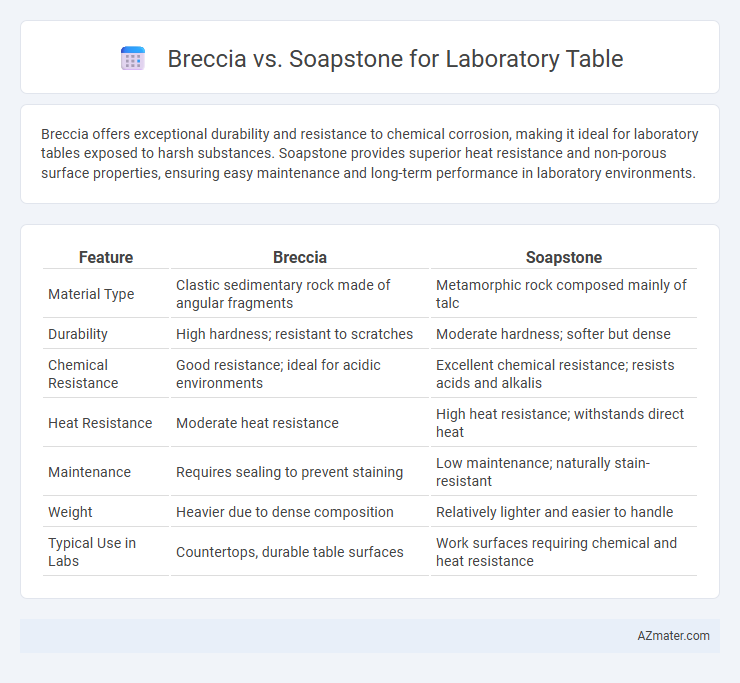Breccia offers exceptional durability and resistance to chemical corrosion, making it ideal for laboratory tables exposed to harsh substances. Soapstone provides superior heat resistance and non-porous surface properties, ensuring easy maintenance and long-term performance in laboratory environments.
Table of Comparison
| Feature | Breccia | Soapstone |
|---|---|---|
| Material Type | Clastic sedimentary rock made of angular fragments | Metamorphic rock composed mainly of talc |
| Durability | High hardness; resistant to scratches | Moderate hardness; softer but dense |
| Chemical Resistance | Good resistance; ideal for acidic environments | Excellent chemical resistance; resists acids and alkalis |
| Heat Resistance | Moderate heat resistance | High heat resistance; withstands direct heat |
| Maintenance | Requires sealing to prevent staining | Low maintenance; naturally stain-resistant |
| Weight | Heavier due to dense composition | Relatively lighter and easier to handle |
| Typical Use in Labs | Countertops, durable table surfaces | Work surfaces requiring chemical and heat resistance |
Introduction: Breccia vs Soapstone for Laboratory Tables
Breccia and soapstone are popular materials used for laboratory tables due to their durability and chemical resistance. Breccia, a natural stone composed of angular fragments bonded by a fine matrix, offers high mechanical strength and a visually striking pattern. Soapstone, primarily made of talc, provides excellent resistance to heat and acids, ensuring longevity in laboratory environments.
Material Composition and Geological Origins
Breccia, a sedimentary rock composed of angular fragments cemented together by a finer matrix, originates from the mechanical weathering and erosion of pre-existing rocks, offering high durability and resistance to chemical corrosion ideal for laboratory tables. Soapstone, primarily made of talc with varying amounts of chlorite, magnesite, and amphiboles, forms through metamorphic processes in ultramafic rocks, known for its heat resistance, non-porosity, and ease of machining. The choice between breccia and soapstone depends on the specific laboratory environment requirements, balancing breccia's hardness and resistance with soapstone's thermal stability and low maintenance.
Physical Properties and Durability
Breccia laboratory tables offer superior hardness and high resistance to abrasion due to their composite structure of angular fragments cemented in a finer matrix, making them ideal for heavy-duty use. Soapstone tables exhibit excellent chemical resistance and moderate heat resistance, attributed to their dense, talc-rich composition, but they are softer and more prone to surface scratching compared to Breccia. Durability in laboratory settings favors Breccia for mechanical strength, while Soapstone is preferred for non-reactive environments requiring chemical inertness and easy maintenance.
Chemical Resistance and Reactivity
Breccia exhibits moderate chemical resistance but can react with strong acids and alkalis, making it less ideal for laboratories handling corrosive substances. Soapstone offers superior chemical resistance due to its dense, non-porous structure, providing excellent stability against most acids, bases, and solvents common in laboratory environments. The inherent reactivity of breccia minerals can compromise its durability, while soapstone's inert composition ensures long-lasting performance and safety in chemical applications.
Maintenance and Cleaning Requirements
Breccia offers a durable and stain-resistant surface that requires minimal maintenance, with simple cleaning involving mild soap and water to preserve its polished finish. Soapstone, known for its non-porous and chemical-resistant properties, demands regular wiping with a soft cloth and occasional oiling to maintain its smooth texture and prevent dullness. Both materials support laboratory hygiene effectively but differ in upkeep, with Breccia favoring low-maintenance routines and Soapstone needing consistent care for longevity.
Aesthetic Appeal and Design Flexibility
Breccia offers a dynamic, variegated appearance with its multicolored, fragmental composition, making it a visually striking choice for laboratory tables that require bold, unique aesthetics. Soapstone provides a smooth, matte finish in soft, consistent tones such as gray or green, delivering a subtle and timeless look that blends seamlessly with various design styles. Breccia's intricate patterns cater to creative, statement-making environments, while soapstone's uniform surface ensures versatile integration and easy customization for functional lab settings.
Cost Comparison and Budget Considerations
Breccia laboratory tables generally come with a higher upfront cost compared to soapstone due to their unique geological composition and limited availability, making them a more premium option. Soapstone, known for its affordability and excellent chemical resistance, often fits better within tighter laboratory budgets while still providing durability and heat resistance. Budget-conscious decisions typically favor soapstone for cost-effective laboratory work surfaces without compromising essential functional properties.
Installation Process and Practical Challenges
Breccia laboratory tables require precise cutting and sealing during installation to maintain their aesthetic and durability, as the stone's natural veining can complicate alignment. Soapstone tables offer easier installation due to their softer texture, allowing for smoother cutting and shaping, but demand careful sealing to prevent staining from chemicals. Both materials necessitate professional handling to address their unique challenges, with breccia's brittleness and soapstone's porosity affecting long-term maintenance in a laboratory environment.
Environmental Impact and Sustainability
Breccia and soapstone differ significantly in environmental impact and sustainability for laboratory tables. Breccia, a type of natural stone composed of fragmented rock pieces, involves quarrying processes that can disrupt ecosystems and generate considerable waste, although its durability supports long-term use. Soapstone, known for its dense and non-porous nature, is often sourced with less environmental degradation and offers excellent longevity and recyclability, making it a more sustainable choice for eco-conscious laboratory environments.
Which Material is Best: Final Recommendations
Breccia offers superior chemical resistance and durability, making it ideal for laboratories handling corrosive substances, while soapstone provides excellent heat resistance and is softer, allowing easier customization but less scratch resistance. For heavy-duty lab environments requiring long-term resilience, breccia is the best choice due to its robustness and low porosity. Soapstone suits laboratories prioritizing chemical neutrality and thermal insulation, especially where heavy impact resistance is less critical.

Infographic: Breccia vs Soapstone for Laboratory Table
 azmater.com
azmater.com